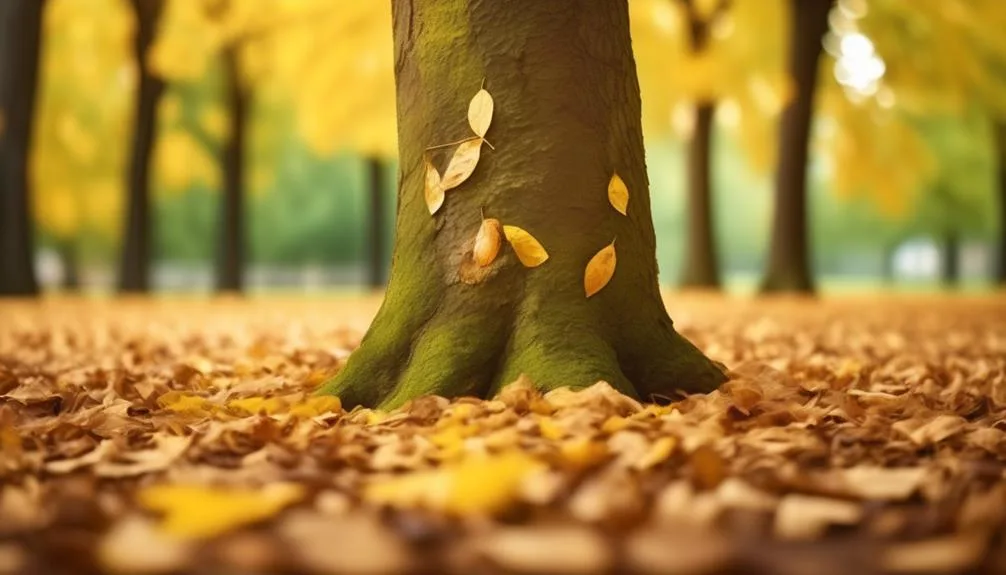Wondering why hickory trees shed their leaves? Understanding this natural process can provide insight into their health.
From seasonal leaf drop to potential stressors and signs of disease, exploring these factors can help you care for your hickory trees.
It's important to recognize the signs and ensure their well-being for the long run.
Leaf Drop in Fall
As the days grow shorter and the temperatures begin to cool, hickory trees prepare for the changing season by shedding their leaves in a vibrant display of autumn colors. This process is a response to the seasonal changes and is completely natural for hickory trees.
The leaves of hickory trees turn brilliant shades of yellow, orange, and red before gracefully falling to the ground. This stunning transformation is a sight to behold and marks the beginning of the tree's transition into the dormancy of winter.
The vibrant hues of autumn colors are a result of chemical processes within the leaves, as they cease chlorophyll production and reveal the pigments that were previously masked. Witnessing this phenomenon is a reminder of nature's ever-changing beauty and the cyclical rhythm of life.
Leaf Drop in Spring
In spring, hickory trees renew their canopy as they shed the remnants of their winter dormancy, ushering in a fresh burst of greenery and vitality to the landscape. This process brings an enchanting display of early blooming, where delicate buds unfurl into vibrant leaves, painting the branches with a tender, verdant hue.
As the trees awaken, the anticipation of nut production fills the air, promising a bountiful harvest to come. Witnessing this natural cycle of growth and renewal can evoke a sense of wonder and appreciation for the resilience and beauty of the hickory trees.
It's a time of transformation, as the landscape is adorned with the promise of new life and the prospect of a plentiful nut yield, igniting a sense of excitement and anticipation in the hearts of onlookers.
Environmental Factors
When considering environmental factors that affect hickory trees, it's crucial to understand how various elements such as soil composition, water availability, and sunlight exposure play a significant role in the overall health and vitality of these majestic trees. Soil moisture levels are particularly important, as hickory trees thrive in well-drained, slightly acidic soils. Inadequate drainage can lead to root rot and other issues. Additionally, temperature fluctuations can impact hickory trees, especially during periods of extreme cold or heat. Sudden temperature changes can stress the trees and affect their ability to retain leaves. To illustrate:
| Environmental Factor | Impact on Hickory Trees |
|---|---|
| Soil moisture | Influences root health and water absorption. |
| Temperature fluctuations | Stress the trees and affect leaf retention. |
Understanding and managing these environmental factors are essential for ensuring the continued health and beauty of hickory trees.
Disease and Pests
Disease and pests can pose significant threats to the health and vitality of hickory trees. This can impact their ability to resist environmental stressors and maintain leaf retention. When fungal infections or insect infestations strike, it can be distressing to witness the once lush foliage dwindling. The sight of leaves marred by disease or ravaged by pests can evoke feelings of concern and helplessness. You desperately seek solutions to protect your beloved hickory tree.
Furthermore, as seasonal changes bring about shifts in temperature and moisture levels, the vulnerability of hickory trees to these external factors becomes apparent. Witnessing the impact of nutrient deficiencies on the tree's overall well-being can be disheartening. It prompts a desire to take immediate action and restore its health.
Proper Care and Maintenance
To maintain the health and vitality of your hickory tree, it's essential to provide proper care and regular maintenance.
When it comes to pruning techniques, it's crucial to remove dead or damaged branches to promote healthy growth and prevent potential disease. Regular pruning also helps maintain the tree's shape and structural integrity.
Additionally, consider the soil health around your hickory tree. Ensure the soil is well-draining and rich in nutrients to support optimal growth. Conduct regular soil tests to assess its pH level and nutrient content, and amend the soil as necessary.
Proper care for your hickory tree also includes watering it deeply during dry periods and mulching around the base to conserve soil moisture and suppress weed growth.
Conclusion
In summary, hickory trees naturally shed leaves in the fall to prepare for winter. Pay attention to any leaf drop outside of this season, as it may indicate underlying issues.
With proper care, your hickory trees can thrive year-round. What signs of distress should we be mindful of in our hickory trees?
Mark Hoffman is a dedicated arborist and tree care specialist with over a decade of experience. His love for trees began when he visited Yosemite National Park as a teenager and was awestruck by the giant sequoias. Mark pursued his passion by studying forestry at Michigan Technological University, where he earned a Bachelor of Science degree.
Since then, he has worked tirelessly in the field of arboriculture, helping to preserve and protect trees in his community. His expertise and dedication have made him a respected leader in the industry and a valuable resource for anyone seeking advice on tree care.
